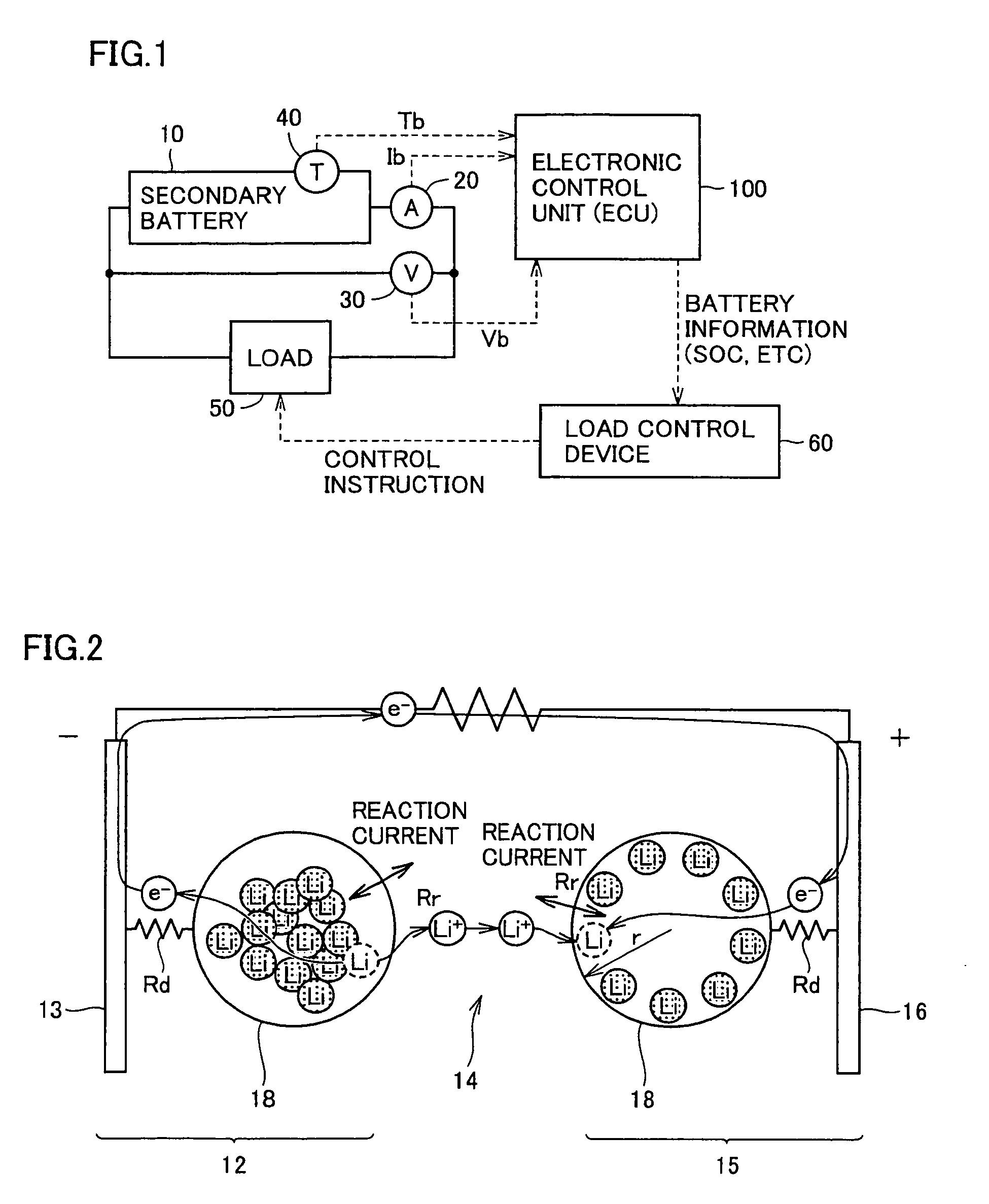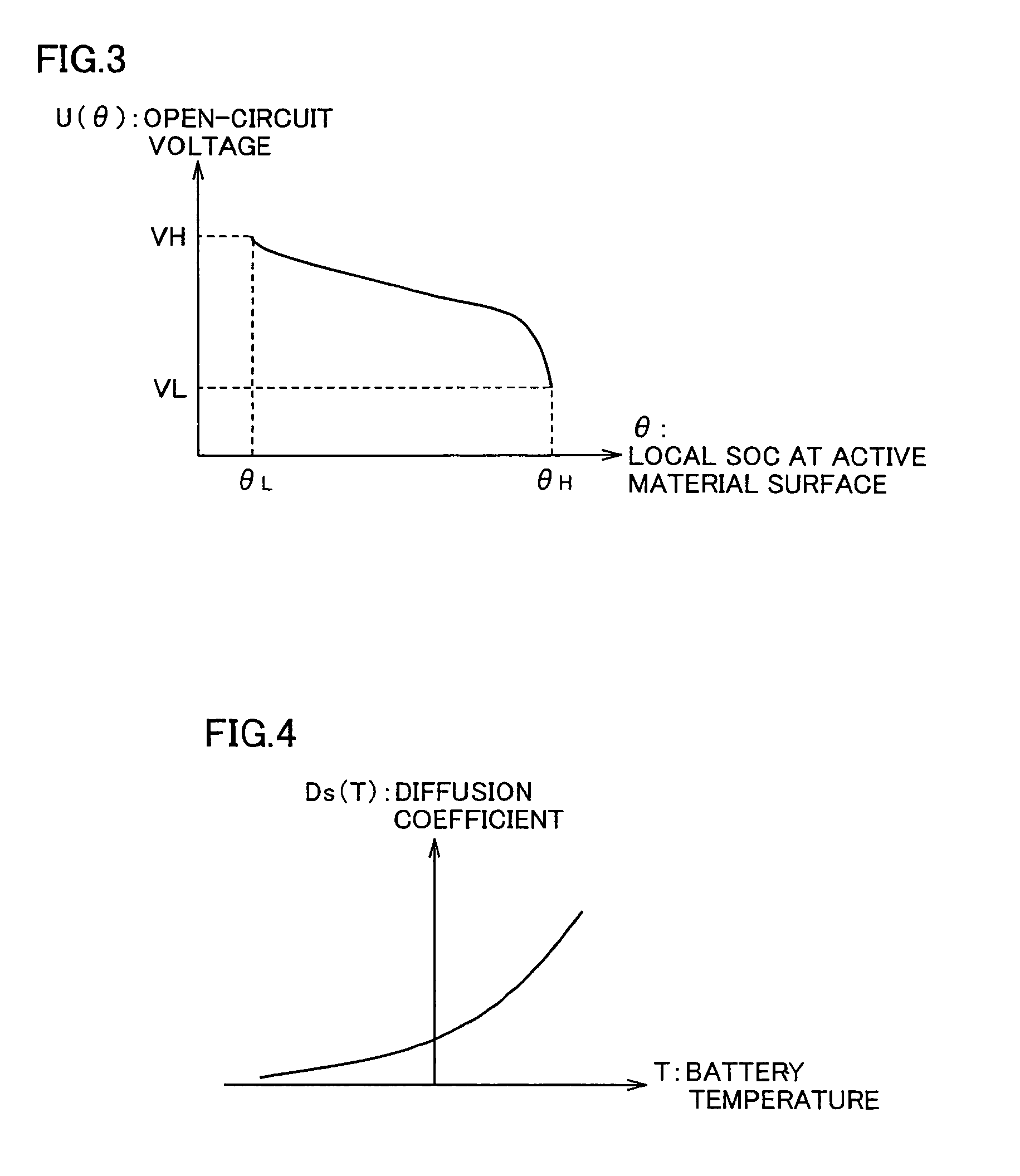State estimating device of secondary battery
a secondary battery and state estimation technology, applied in the field of state estimation device of secondary batteries, can solve the problems of increasing arithmetic quantity, insufficient estimation accuracy, and difficult to achieve a sufficiently high accuracy, so as to prevent the occurrence of estimation errors, the degree of battery deterioration can be accurately estimated, and the estimation accuracy is improved.
- Summary
- Abstract
- Description
- Claims
- Application Information
AI Technical Summary
Benefits of technology
Problems solved by technology
Method used
Image
Examples
first embodiment
[0132]Among the parameters in the battery model equation, DC resistance Ra changes according to the battery states such as battery temperature Tb and local SOC θ already described, and also changes due to secular deterioration caused by use of the battery. Accordingly, an error occurs in the estimated SOC when a difference occurs between the actual DC resistance and DC resistance Ra, in the initial state (typically, in the new state) stored in the DC resistance map used in the battery model. The initial state is not restricted to the new state, and may be defined as the state intermediate between the new state and an expected maximally deteriorated state. As will be apparent from the following description, this definition can narrow the range of the estimated change rate value with respect to the initial state parameter value, and therefore can improve the estimation accuracy.
[0133]Therefore, the first embodiment will be described below in connection with the following structures. T...
second embodiment
[0193]When the battery deteriorates, the DC resistances such as the charge-transfer resistance and the pure resistance increase, and further the diffusion speed of the reaction-participating material in the active material lowers (i.e., the diffusion coefficient lowers) so that the so-called diffusion resistance increases. The increase in diffusion resistance significantly affects the battery performance and the current-voltage characteristics particularly in the case where the Charge and discharge continue with large currents. In the hybrid vehicle and electric vehicle that perform the charge and discharge with large currents, therefore, it is an important matter to estimate the changes in diffusion resistance, i.e., changes in diffusion coefficient of the active material.
[0194]The second embodiment will be described below in connection with lithium diffusion coefficient Ds in the active material, which is one of the parameters of the foregoing battery model, and particularly to th...
third embodiment
[0269]As described above, the processing of estimating the DC resistance change rate in accordance with the block diagram of FIG. 7 and the processing of estimating the diffusion coefficient change rate in accordance with the block diagram m of FIG. 12 can be executed independently of each other by ECU 100. Therefore, the state estimating device of the secondary battery can be configured to execute in parallel the estimation of the DC resistance change rate according to the first embodiment and the estimation of the diffusion coefficient change rate according to the second embodiment. According to this configuration, the battery behaviors (typically, the SOC) can be accurately estimated even in the secondary battery having both the DC resistance and the diffusion resistance that have increased due to the deterioration. The deterioration of the DC resistance can be detected independently of the deterioration of the diffusion resistance.
[0270]However, when the estimation of the DC res...
PUM
| Property | Measurement | Unit |
|---|---|---|
| voltage | aaaaa | aaaaa |
| current | aaaaa | aaaaa |
| temperature | aaaaa | aaaaa |
Abstract
Description
Claims
Application Information
 Login to View More
Login to View More - R&D
- Intellectual Property
- Life Sciences
- Materials
- Tech Scout
- Unparalleled Data Quality
- Higher Quality Content
- 60% Fewer Hallucinations
Browse by: Latest US Patents, China's latest patents, Technical Efficacy Thesaurus, Application Domain, Technology Topic, Popular Technical Reports.
© 2025 PatSnap. All rights reserved.Legal|Privacy policy|Modern Slavery Act Transparency Statement|Sitemap|About US| Contact US: help@patsnap.com



